On-Chip Cell Incubator for Simultaneous Observation of Culture with and without Periodic Hydrostatic Pressure
Abstract
1. Introduction
2. Materials and Method
2.1. Periodic Hydrostatic Pressure and Optimum Stimulus
2.2. Development of Cell Incubator and Pressure Control
2.3. Chip Preparation and Experimental Procedure
3. Results
3.1. Projected Area of Cells with and without Periodic Hydrostatic Pressure
3.2. Periodic Characteristics in Cell Growth
3.3. Frequency Analysis on Projected Area of Cells
4. Discussion
5. Conclusions
Supplementary Materials
Author Contributions
Acknowledgments
Conflicts of Interest
Appendix A

References
- Sies, H.; Berndt, C.; Jones, D.P. Oxidative stress. Annu. Rev. Biochem. 2017, 86, 715–748. [Google Scholar] [CrossRef] [PubMed]
- Olagnier, D.; Peri, S.; Steel, C.; Van Montfoort, N.; Chiang, C.; Beljanski, V.; Slifker, M.; He, Z.; Nichols, C.N.; Lin, R.; et al. Cellular Oxidative Stress Response Controls the Antiviral and Apoptotic Programs in Dengue Virus-Infected Dendritic Cells. PLoS Pathog 2014, 10, e1004566. [Google Scholar] [CrossRef] [PubMed]
- Veschgini, M.; Gebert, F.; Khangai, N.; Ito, H.; Suzuki, R.; Holstein, T.W.; Mae, Y.; Arai, T.; Tanaka, M. Tracking mechanical and morphological dynamics of regenerating Hydra tissue fragments using a two fingered micro-robotic hand. Appl. Phys. Lett. 2016, 108, 103702. [Google Scholar] [CrossRef]
- Murakami, R.; Tsai, C.-H.D.; Ito, H.; Tanaka, M.; Sakuma, S.; Arai, F.; Kaneko, M. Catch, load and launch toward on-chip active cell evaluation. In Proceedings of the 2016 IEEE International Conference on Robotics and Automation (ICRA), Stockholm, Sweden, 16–21 May 2016; pp. 1713–1718. [Google Scholar]
- Ohara, K.; Kawakami, D.; Takubo, T.; Mae, Y.; Tanikawa, T.; Honda, A.; Arai, T. Dextrous cell diagnosis using two-fingered microhand with micro force sensor. J. Micro Nano Mechatron. 2012, 7, 13–20. [Google Scholar] [CrossRef]
- Horade, M.; Tsai, C.-H.D.; Ito, H.; Kaneko, M. Red Blood Cell Responses during a Long-Standing Load in a Microfluidic Constriction. Micromachines 2017, 8, 100. [Google Scholar] [CrossRef]
- Ito, H.; Murakami, R.; Sakuma, S.; Tsai, C.-H.D.; Gutsmann, T.; Brandenburg, K.; Pöschl, J.M.B.; Arai, F.; Kaneko, M.; Tanaka, M. Mechanical diagnosis of human erythrocytes by ultra-high speed manipulation unraveled critical time window for global cytoskeletal remodeling. Sci. Rep. 2017, 7, 43134. [Google Scholar] [CrossRef] [PubMed]
- Di Cara, F.; Maile, T.M.; Parsons, B.D.; Magico, A.; Basu, S.; Tapon, N.; King-Jones, K. The Hippo pathway promotes cell survival in response to chemical stress. Cell Death Differ. 2015, 22, 1526–1539. [Google Scholar] [CrossRef] [PubMed]
- Seo, K.; Rainer, P.P.; Lee, D.I.; Hao, S.; Bedja, D.; Birnbaumer, L.; Cingolani, O.H.; Kass, D.A. Hyperactive Adverse Mechanical Stress Responses in Dystrophic Heart Are Coupled to Transient Receptor Potential Canonical 6 and Blocked by cGMP–Protein Kinase G Modulation. Circ. Res. 2014, 114, 823–832. [Google Scholar] [CrossRef] [PubMed]
- Sakuma, S.; Kuroda, K.; Tsai, C.-H.D.; Fukui, W.; Arai, F.; Kaneko, M. Red blood cell fatigue evaluation based on the close-encountering point between extensibility and recoverability. Lab Chip 2014, 14, 1135. [Google Scholar] [CrossRef]
- Teramura, T.; Takehara, T.; Onodera, Y.; Nakagawa, K.; Hamanishi, C.; Fukuda, K. Mechanical stimulation of cyclic tensile strain induces reduction of pluripotent related gene expressions via activation of Rho/ROCK and subsequent decreasing of AKT phosphorylation in human induced pluripotent stem cells. Biochem. Biophys. Res. Commun. 2012, 417, 836–841. [Google Scholar] [CrossRef]
- Subramony, S.D.; Dargis, B.R.; Castillo, M.; Azeloglu, E.U.; Tracey, M.S.; Su, A.; Lu, H.H. The guidance of stem cell differentiation by substrate alignment and mechanical stimulation. Biomaterials 2013, 34, 1942–1953. [Google Scholar] [CrossRef] [PubMed]
- Itoh, M.; Nakayama, K.; Noguchi, R.; Kamohara, K.; Furukawa, K.; Uchihashi, K.; Toda, S.; Oyama, J.-I.; Node, K.; Morita, S. Scaffold-Free Tubular Tissues Created by a Bio-3D Printer Undergo Remodeling and Endothelialization when Implanted in Rat Aortae. PLoS ONE 2015, 10, e0136681. [Google Scholar]
- Lee, V.K.; Kim, D.Y.; Ngo, H.; Lee, Y.; Seo, L.; Yoo, S.-S.; Vincent, P.A.; Dai, G. Creating perfused functional vascular channels using 3D bio-printing technology. Biomaterials 2014, 35, 8092–8102. [Google Scholar] [CrossRef]
- Murphy, S.V.; Atala, A. 3D bioprinting of tissues and organs. Nat. Biotechnol. 2014, 32, 773–785. [Google Scholar] [CrossRef] [PubMed]
- Yokoyama, U.; Tonooka, Y.; Koretake, R.; Akimoto, T.; Gonda, Y.; Saito, J.; Umemura, M.; Fujita, T.; Sakuma, S.; Arai, F.; et al. Arterial graft with elastic layer structure grown from cells. Sci. Rep. 2017, 7, 427. [Google Scholar] [CrossRef] [PubMed]
- Horade, M.; Kaneko, M.; Tsai, C.D.; Ito, H.; Higashino, N.; Akai, T.; Yokoyma, U.; Ishikawa, Y.; Sakuma, S.; Arai, F. On-Chip Cell Gym. In Proceedings of the 30th IEEE Conference on Micro Electro Mechanical Systems (MEMS2017), Las Vegas, NV, USA, 22–26 January 2017; pp. 603–604. [Google Scholar]
- Buschmann, M.D.; Gluzband, Y.A.; Grodzinsky, A.J.; Hunziker, E.B. Mechanical compression modulates matrix biosynthesis in chondrocytelagarose culture. J. Cell Sci. 1995, 108, 1497–1508. [Google Scholar] [PubMed]
- Carver, S.E.; Heath, C.A. Increasing extracellular matrix production in regenerating cartilage with intermittent physiological pressure. Biotechnol. Bioeng. 1999, 62, 166–174. [Google Scholar] [CrossRef]
- Hall, A.C.; Urban, J.P.G.; Gehl, K.A. The effects of hydrostatic pressure on matrix synthesis in articular cartilage. J. Orthop. Res. 1991, 9, 1–10. [Google Scholar] [CrossRef]
- Suh, J.K.; Baek, G.H.; Årøen, A.; Malin, C.M.; Niyibizi, C.; Evans, C.H.; Westerhausen-Larson, A. Intermittent sub-ambient interstitial hydrostatic pressure as a potential mechanical stimulator for chondrocyte metabolism. Osteoarthr. Cartil. 1999, 7, 71–80. [Google Scholar] [CrossRef]
- Horade, M.; Mizuta, Y.; Kaji, N.; Higashiyama, T.; Arata, H. Plant-on-a-chip microfluidic-system for quantitative analysis of pollen tube guidance by signaling molecule: Towards cell-to-cell communication study. In Proceedings of the 16th International Conference on Miniaturized Systems for Chemistry and Life Sciences (MicroTAS 2012), Okinawa, Japan, 28 October–1 November 2012; pp. 1027–1029. [Google Scholar]
- Yasaki, H.; Yasui, T.; Yanagida, T.; Kaji, N.; Kanaki, M.; Fukuyama, M.; Nagashima, K.; Kawai, T.; Baba, Y. Microfluidic long-pore-channel to highlight bacteria contents. In Proceedings of the 20th International Conference on Miniaturized Systems for Chemistry and Life Sciences (MicroTAS 2016), Dublin, Ireland, 9–13 October 2016; pp. 101–102. [Google Scholar]
- Shimizu, K.; Shunori, A.; Morimoto, K.; Hashida, M.; Konishi, S. Development of a biochip with serially connected pneumatic balloons for cell-stretching culture. Sens. Actuators B Chem. 2011, 156, 486–493. [Google Scholar] [CrossRef]
- Eyer, K.; Kuhn, P.; Hanke, C.; Dittrich, P.S. A microchamber array for single cell isolation and analysis of intracellular biomolecules. Lab Chip 2012, 12, 765–772. [Google Scholar] [CrossRef] [PubMed]
- Anderson, J.R.; Chiu, D.T.; Jackman, R.J.; Cherniavskaya, O.; McDonald, J.C.; Wu, H.; Whitesides, S.H.; Whitesides, G.M. Fabrication of Topologically Complex Three-Dimensional Microfluidic Systems in PDMS by Rapid Prototyping. Anal. Chem. 2000, 72, 3158–3164. [Google Scholar] [CrossRef] [PubMed]
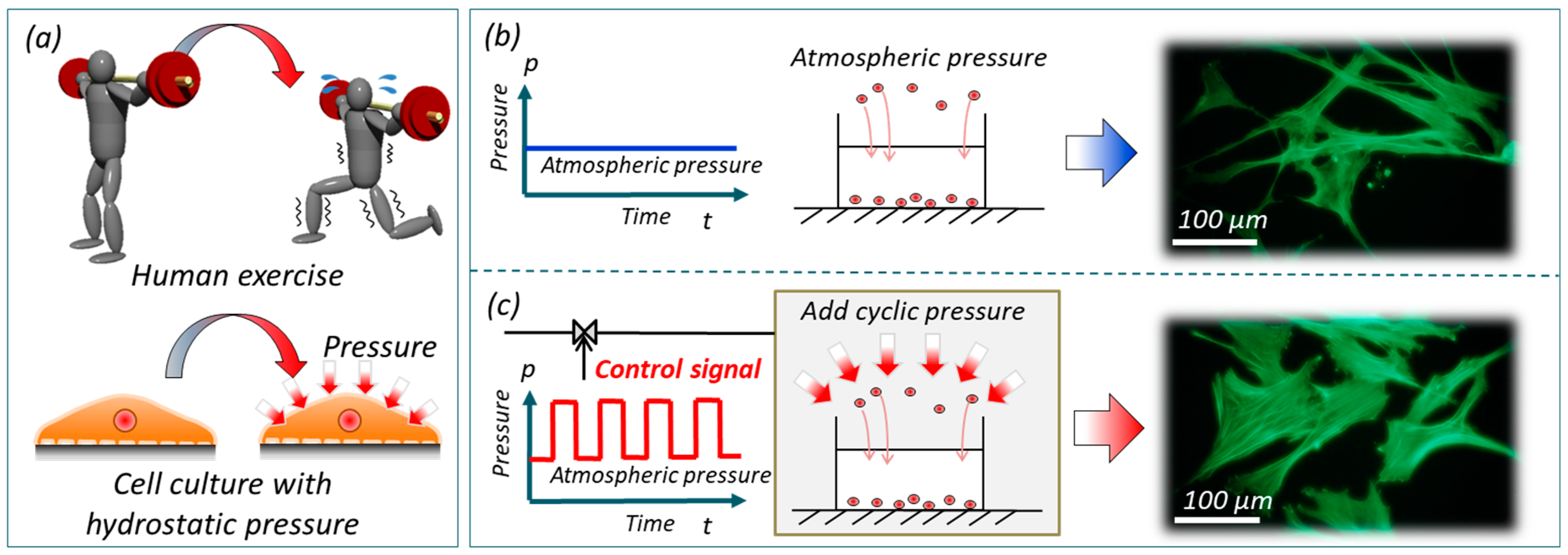

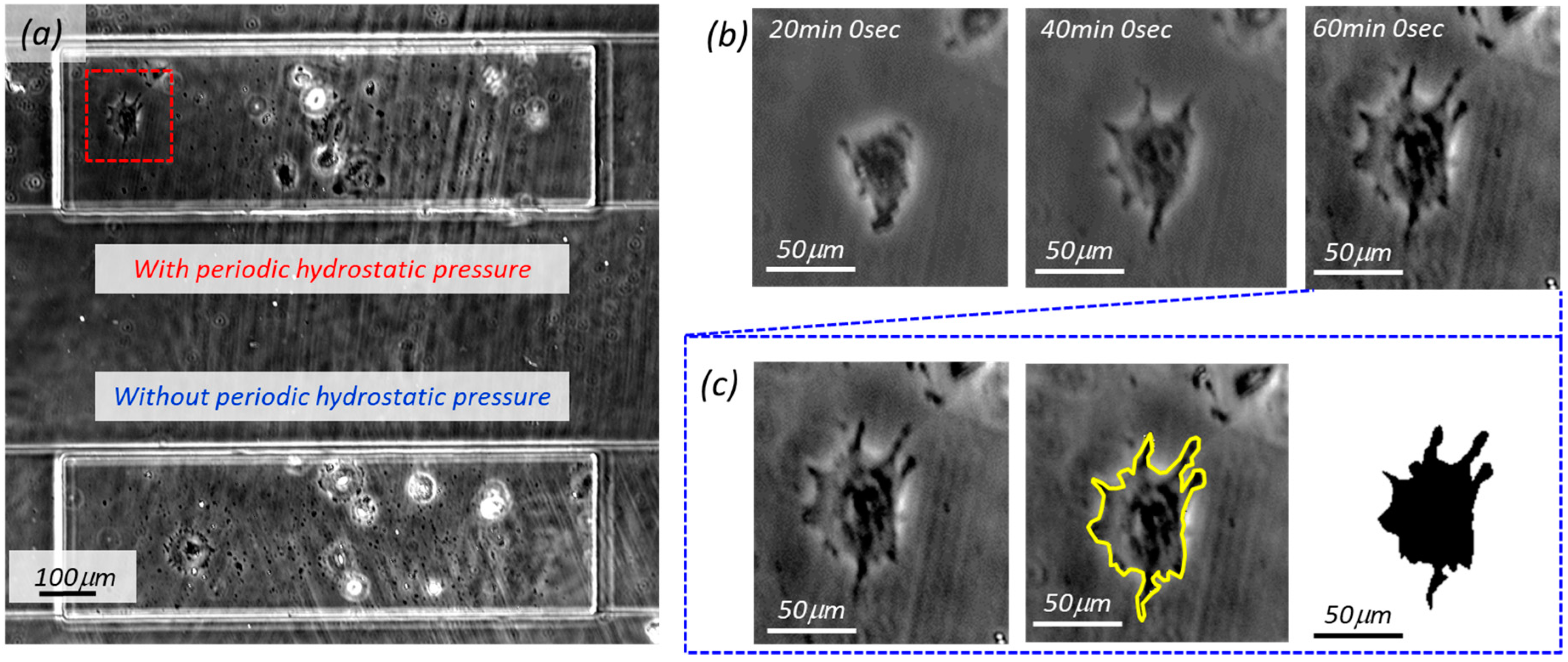

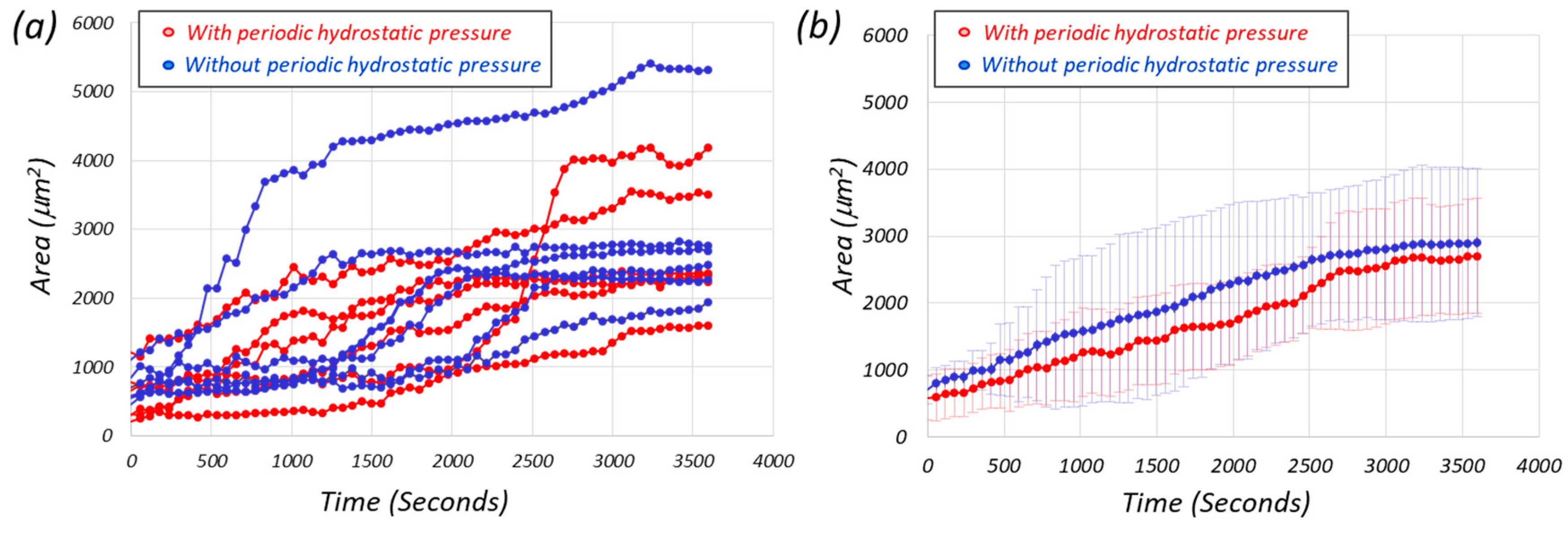
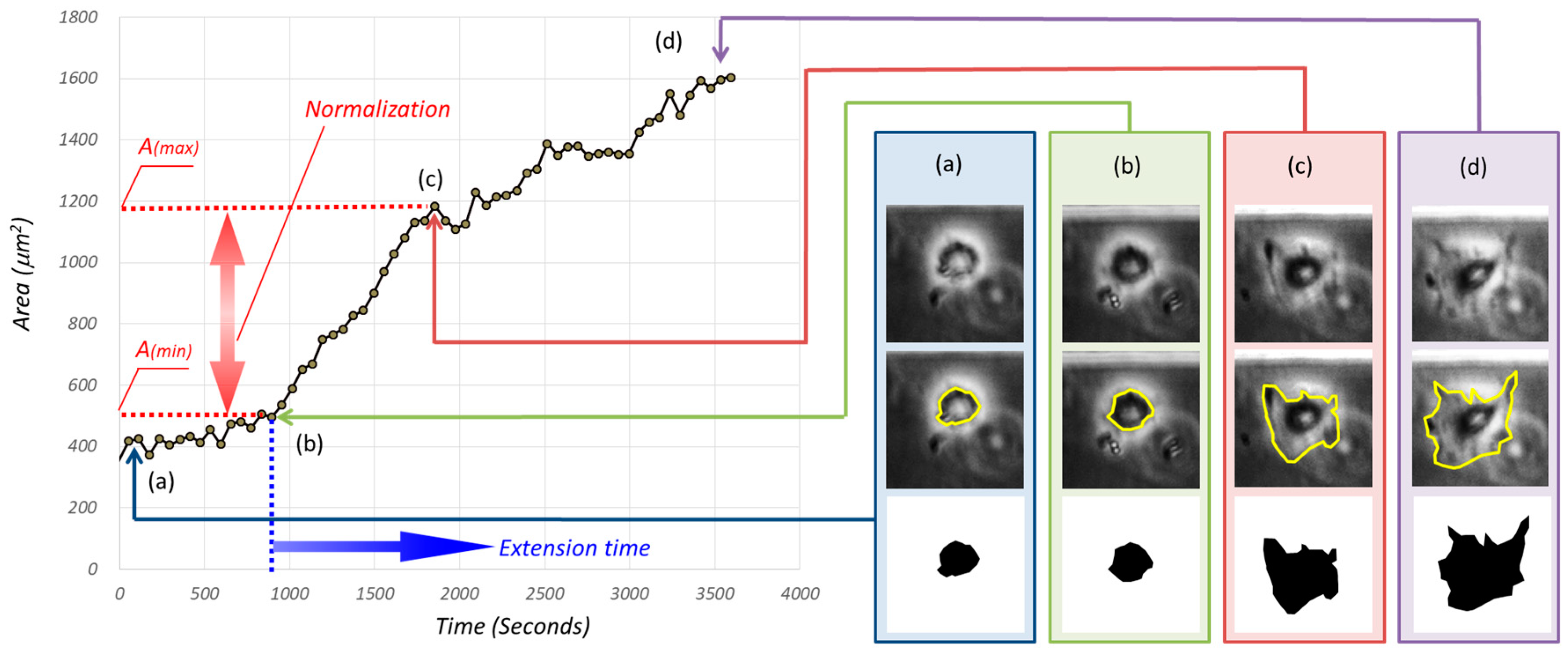
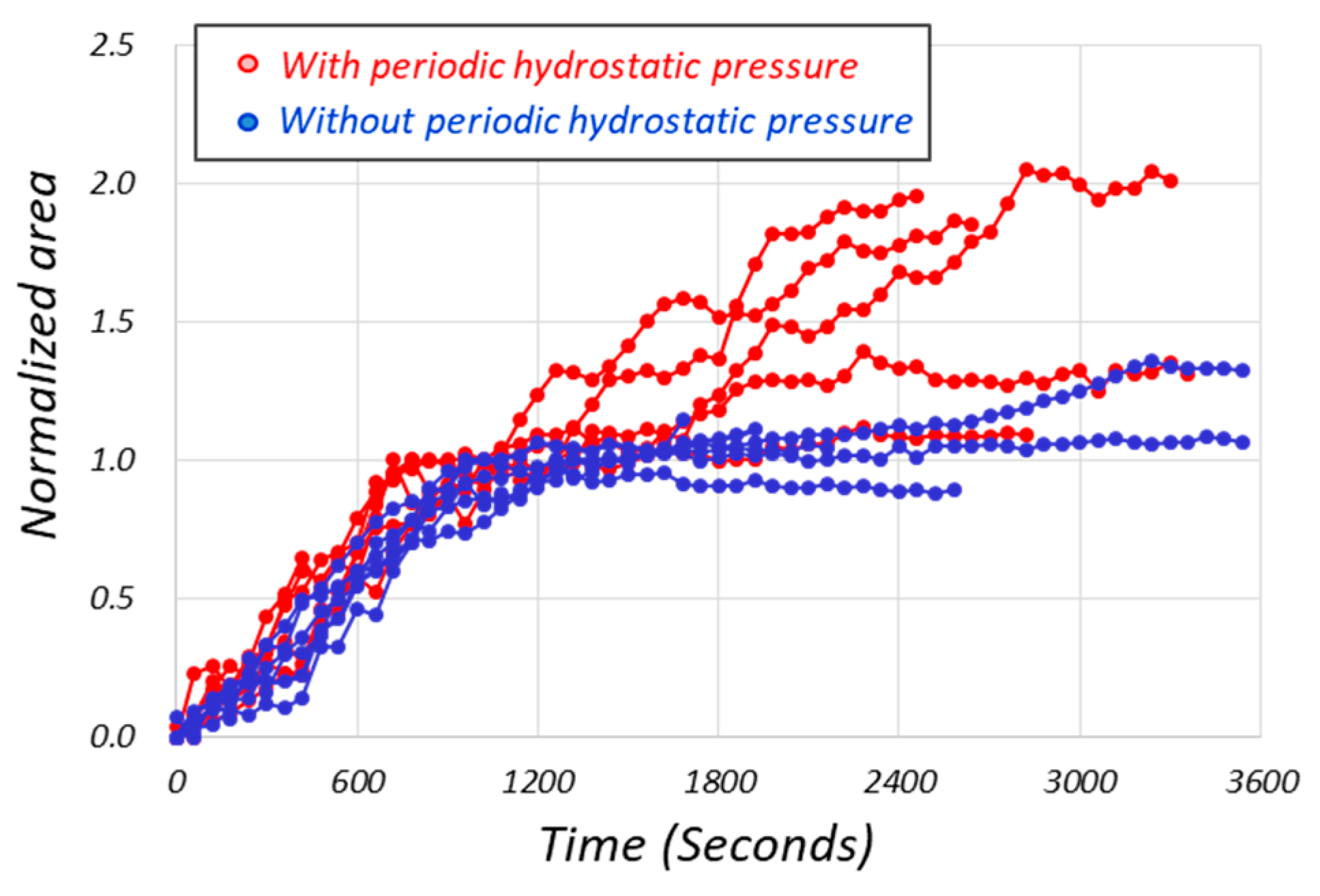
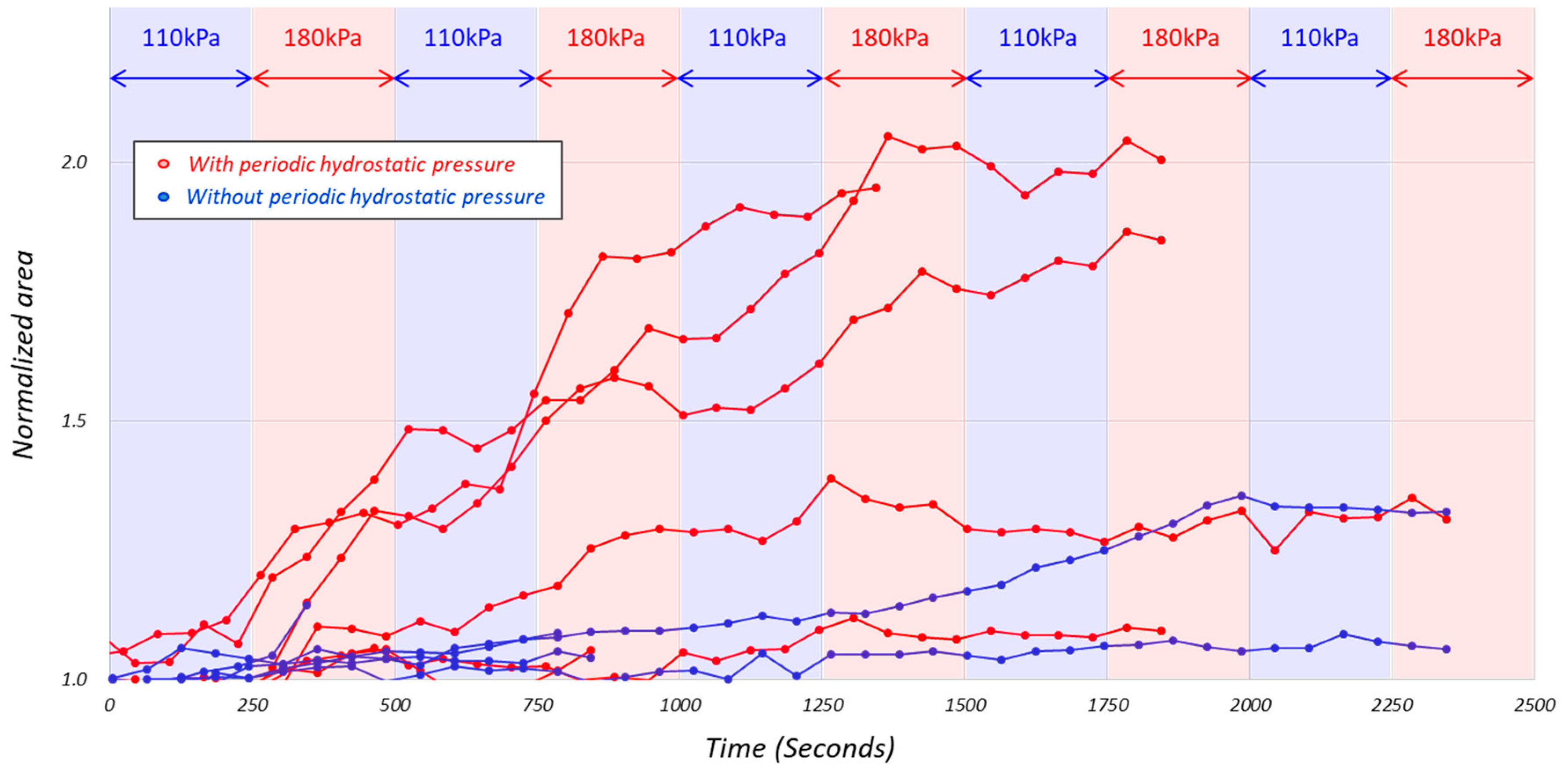
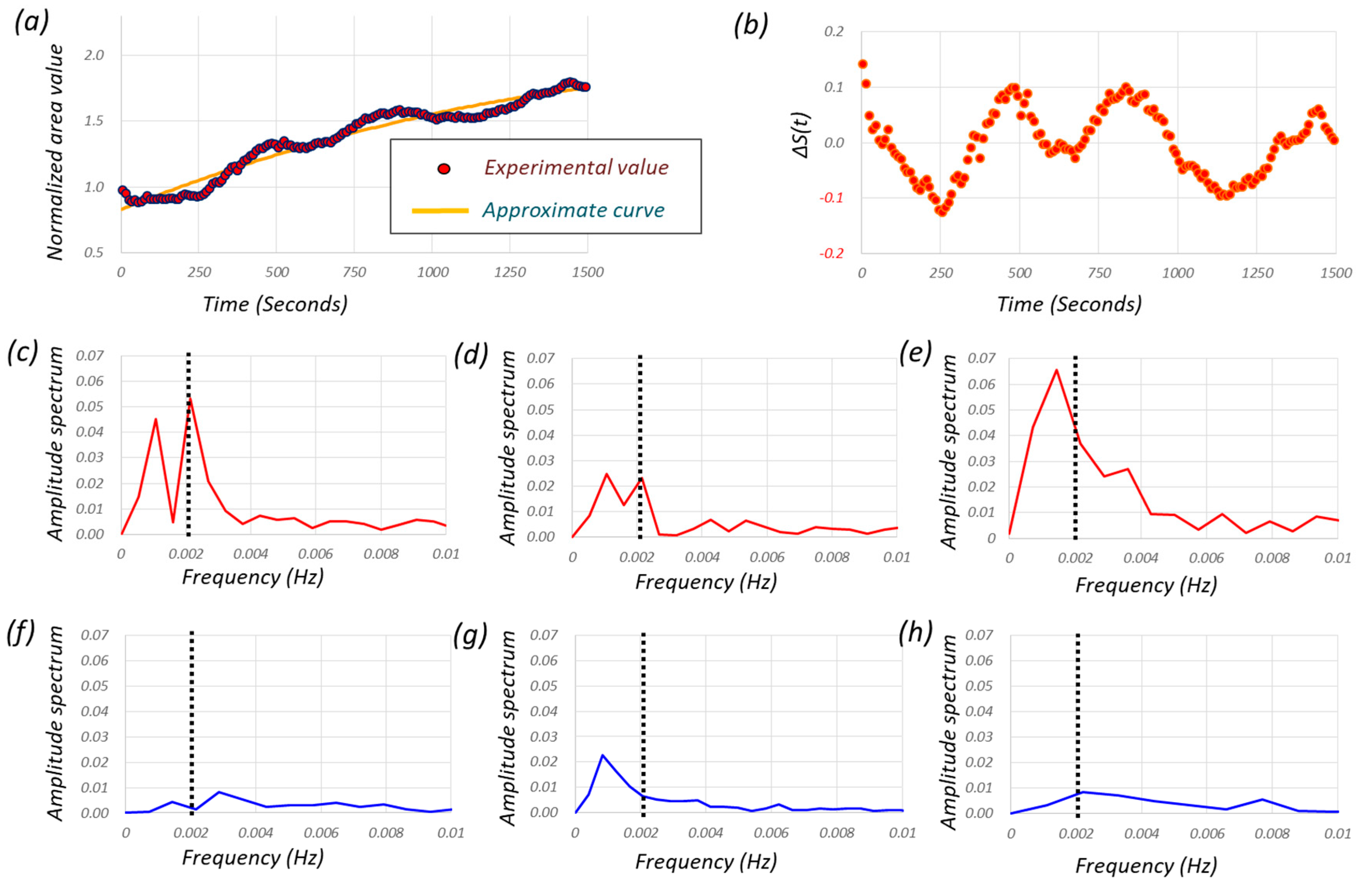
© 2019 by the authors. Licensee MDPI, Basel, Switzerland. This article is an open access article distributed under the terms and conditions of the Creative Commons Attribution (CC BY) license (http://creativecommons.org/licenses/by/4.0/).
Share and Cite
Horade, M.; Tsai, C.-H.D.; Kaneko, M. On-Chip Cell Incubator for Simultaneous Observation of Culture with and without Periodic Hydrostatic Pressure. Micromachines 2019, 10, 133. https://doi.org/10.3390/mi10020133
Horade M, Tsai C-HD, Kaneko M. On-Chip Cell Incubator for Simultaneous Observation of Culture with and without Periodic Hydrostatic Pressure. Micromachines. 2019; 10(2):133. https://doi.org/10.3390/mi10020133
Chicago/Turabian StyleHorade, Mitsuhiro, Chia-Hung Dylan Tsai, and Makoto Kaneko. 2019. "On-Chip Cell Incubator for Simultaneous Observation of Culture with and without Periodic Hydrostatic Pressure" Micromachines 10, no. 2: 133. https://doi.org/10.3390/mi10020133
APA StyleHorade, M., Tsai, C.-H. D., & Kaneko, M. (2019). On-Chip Cell Incubator for Simultaneous Observation of Culture with and without Periodic Hydrostatic Pressure. Micromachines, 10(2), 133. https://doi.org/10.3390/mi10020133





